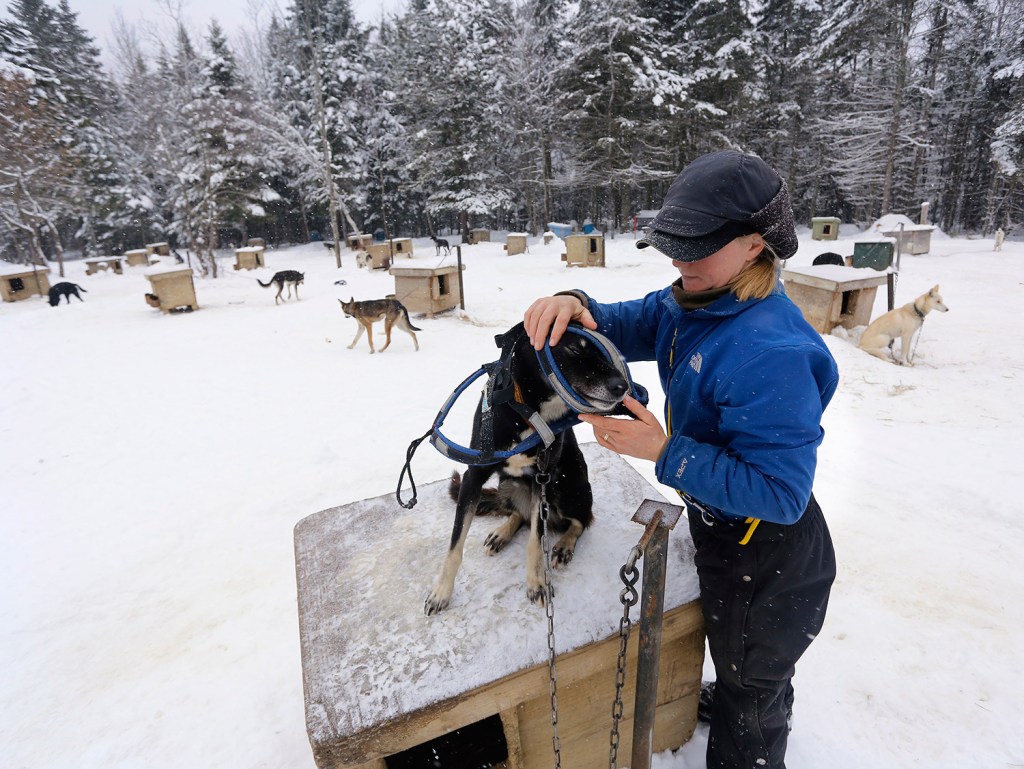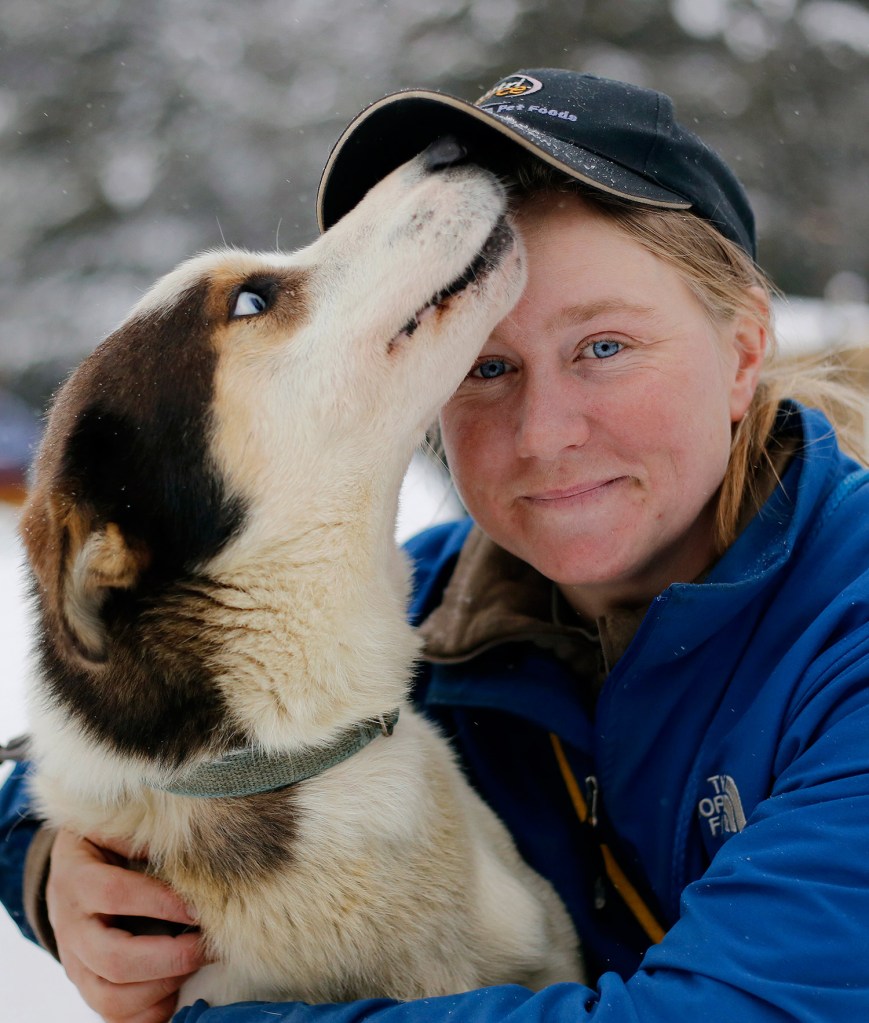SHIRLEY — For 22 years, the people of Fort Kent have rallied around the town’s sled-dog race, the longest in the eastern United States. They’ve stood along Main Street predawn to cheer the men who’ve won the Can-Am Crown 250.
Now, some think a change is coming. An increase in competitive female mushers entering the 250-mile race gives locals reason to believe the next Can-Am winner could be a woman, maybe even a Mainer.
“We’re hoping for a woman to win it. Because it would be a first,” said Allan Dow, the race director. “One woman comes from British Columbia every year, a couple from Minnesota. They love it. They all get together and talk shop.”
Historically, the Fort Kent race has drawn male mushers from Canada, Minnesota and Michigan. Three-time winner Don Hibbs of Millinocket is the only Maine musher to capture the crown. But in the past few years, more women have entered.
One vying for the title this winter will be Ashley Patterson of Shirley, who has completed the race three times running dogs from another kennel. This year she will compete with her own team.
“I’d say having my own dogs to race and finish with will be more of a deep-down good feeling. The sport is something of a passion,” said Patterson, who owns Lone Wolf Kennel near Moosehead Lake with her husband, Mark.
Also in the field on Feb. 28 will be the race’s most successful woman musher: Rita Wehseler of Minnesota.
In 2001, Wehseler, then Rita Lensing, became the first female musher to finish the Can-Am 250. She returned in 2007 and took second, passing Hibbs in the final seven miles. She finished third in 2009 and 2012.
“In 2001, I’ll never forget it, when I got to the second checkpoint, I came in and an official wanted to talk to me, but I said, ‘Everyone leave me alone, I have my dogs to take care of,'” Wehseler said in a phone interview from the north shore of Lake Superior.
“At the third checkpoint, this woman checker said she wanted to shake my hand. She said, ‘Do you realize you are the first woman musher ever to make it beyond the first checkpoint?’ I had no idea.”
Competitive women mushers have been racing distances of 200 miles or more in Alaska, Minnesota, Michigan and Canada for decades. But Wehseler said the face of the Northeast’s longest sled-dog race finally has changed to include a strong contingent of women.
Of the 18 mushers who entered the 2014 race, five were women. Of the 15 mushers registered so far for this winter’s race, seven are women. They hail from as far away as Montana.
“The past three years, there are more women looking to buy sled dogs. That’s when I noticed. Some work second jobs so they can run dogs,” Patterson said.
A decade ago, Patterson became the youngest woman to finish the Can-Am 250 at 18. Her last appearance in the race was in 2008, with a team from another kennel. Last winter, she ran a team from her own kennel in the Can-Am’s 60-mile race and took seventh.
Now 29, Patterson thinks the era of the competitive female musher has arrived in Maine.
“Mushing is no different for women or men,” she said. “You have to push your team, but not push too much. You lose the dogs’ trust, you have to gain it back.”
The race has a $40,000 purse, and the winner will go home with at least $4,500 and as much as $7,000, depending on stage results. But the cost of raising a large, healthy kennel of 20 to 50 dogs costs tens of thousands of dollars, Patterson said.
Dow, the race director, gleefully calls it a “disease.”
Patterson said it is a lifestyle.
In the summer, the Pattersons guide fishermen, hikers and wildlife watchers on moose safaris. In the winter, they run sled-dog trips, and train and race dogs as often as they can.
From dawn to dusk most winter days, Ashley Patterson prepares teams of 12 dogs with ointment on their paws, booties on top of that, and a harness around each dog. She does this repeatedly with Mark’s help.
As the mushers select the dogs for the next training run, more than 40 other Alaskan huskies howl and whine.
When 12 dogs finally are harnessed, the team falls quiet, as if in anticipation of the start. Then they’re gone.
The dogs are led on training runs that range in distance from 3 to 25 miles. If it’s a shorter distance, Patterson will run multiple teams in a single day.
“Dogs feed off emotion,” she said. “You have to get everything just right. It’s not always that magic carpet ride. I’m always thinking of better ways to do things.”
The Iditarod is the goal for Patterson. Finishing the Can-Am 250 would qualify her for the 1,100-mile Alaskan race, or the 1,000-mile Yukon Quest, Alaska’s other sled-dog marathon.
“This is my life. But if you want to do the Yukon Quest, it has to be your life,” Patterson said.
Not even Wehseler, a musher of 20 years and an eight-time Can-Am 250 finisher, has competed in the Alaskan races. Her goal also is to one day run the Iditarod or Yukon Quest.
“It’s so expensive,” Wehseler said. “But every race car driver’s dream is to do the Indy 500, and every dog musher’s dream is to do the Iditarod or Yukon Quest.”
Wehseler has another ambition. She said she wants one more top-three finish in Fort Kent.
She paused, then added, “I’ll say it: my goal is to win the Can-Am. Whether that’s possible, I don’t know.”
Copy the Story LinkSend questions/comments to the editors.











Success. Please wait for the page to reload. If the page does not reload within 5 seconds, please refresh the page.
Enter your email and password to access comments.
Hi, to comment on stories you must . This profile is in addition to your subscription and website login.
Already have a commenting profile? .
Invalid username/password.
Please check your email to confirm and complete your registration.
Only subscribers are eligible to post comments. Please subscribe or login first for digital access. Here’s why.
Use the form below to reset your password. When you've submitted your account email, we will send an email with a reset code.